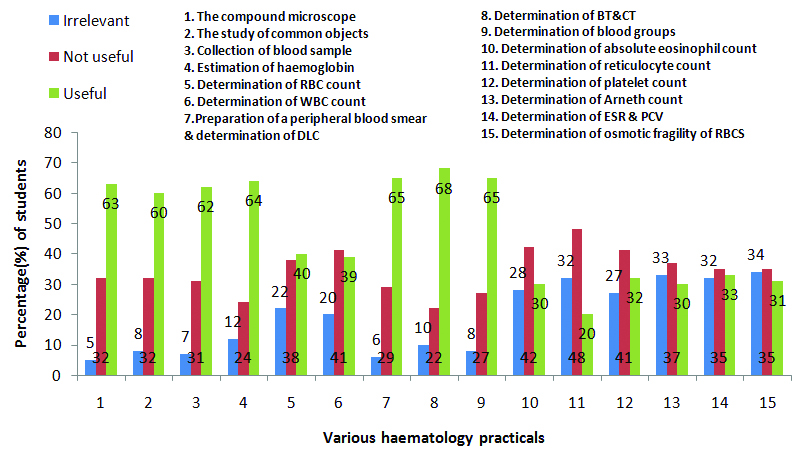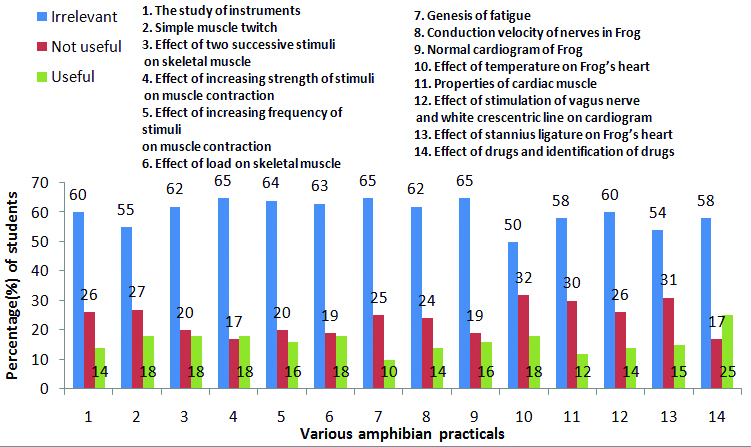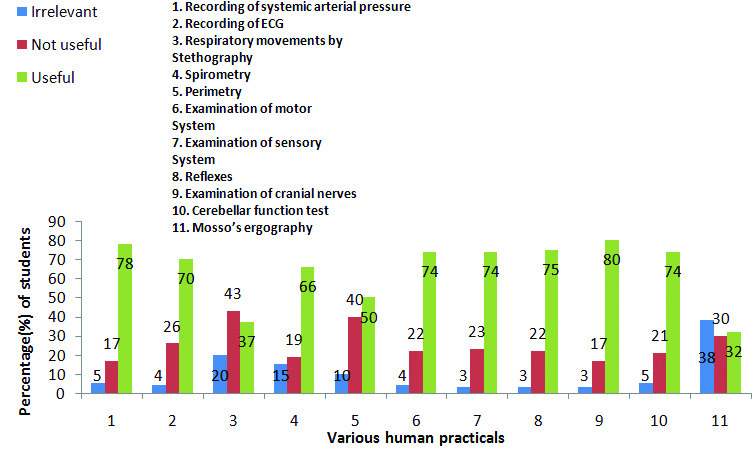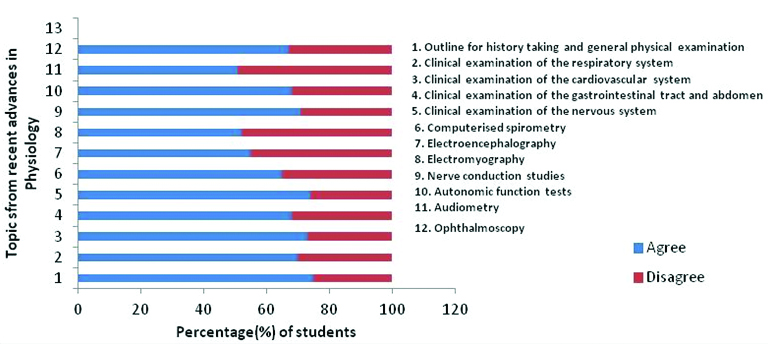Need for Changes in the Practical Physiology Curriculum of Medical Undergraduates
Rajni Goyal1, Rajveer Garg2, Puneet Raj Goyal3
1 Associate Professor, Department of Physiology, Gian Sagar Medical College and Hospital, Ramnagar, Patiala, Punjab, India.
2 Consultant, Department of Neurosurgery, Ivy Hospital, Panchkula, Haryana, India.
3 Assistant Professor, Department of Radiodiagnosis, Gian Sagar Medical College and Hospital, Ramnagar, Patiala, Punjab, India.
NAME, ADDRESS, E-MAIL ID OF THE CORRESPONDING AUTHOR: Dr. Rajveer Garg, Consultant, Department of Neurosurgery, Ivy Hospital, Panchkula-134112, Haryana, India.
E-mail: dr.rg2482@gmail.com
Introduction
Physiology is one of the foundation sciences for the medical curriculum. It forms the basis of all life sciences. Physiology practical classes in India are divided into three sections: exercises in haematology, exercises on humans and experiments on amphibians. Faculty and students of medical schools in India are of the opinion that animal experiments should be discontinued, that the curriculum in experimental physiology and pharmacology needs to be updated, that the same understanding of topics could be obtained by using alternative methods and that there is an urgent need to introduce alternatives of animal experiments.
Aim
To assess the need for changes in the practical physiology curriculum of medical undergraduates.
Materials and Methods
The study was conducted among 300 MBBS, second and third professional students using a semi-structured questionnaire. The questionnaire consisted of two sections: the first section was based on the current experimental physiology curriculum regarding the relevance of topics taught in haematology, amphibian and human practical classes. In the second section, the opinion was also sought regarding introduction of new topics related to recent advances in clinical physiology and basic clinical skills.
Results
More than 60% of the students marked most of the haematology experiments useful. All the amphibian practicals were considered irrelevant/not useful by more than 75% of the students. Regarding the human experiments, more than 70% of the students marked useful. More than 65% students were of the opinion that basic clinical skills should be introduced at undergraduate level. More than 50% students favoured introduction of topics from recent advances in physiology.
Conclusion
The present study concludes that there is an imperative need to implement radical changes in the experimental physiology curriculum which should be in consonance with patient care for the doctors of tomorrow to render better health service.
Amphibian, Haematology, Human clinical
Introduction
In India, physiology is taught in the first year of the medical school of the Bachelor of Medicine and Bachelor of Surgery course (MBBS course four and a half years plus one year internship) [1]. A physiologist can play a part in giving the student and practitioner a vantage point from which he may gain a rational view of the pathological processes [2].
The practical physiology curriculum for the undergraduate medical student in first MBBS includes haematology, basic clinical skills and amphibian experiments [1]. Animal experiments were previously being used in physiology departments of all medical schools in India for the training of both undergraduates and postgraduates. However, the Government of India has recently issued guidelines to the Medical Council of India (MCI) to discontinue live animal experiments for the training of medical students, and instead use alternatives to animal experimentation [3]. Hence, amphibian (nerve-muscle and heart muscle) experiments in many medical schools in India, are taught using graphs obtained from studies conducted in the previous year’s [4].
Faculty and students of medical schools in India are also of the opinion that animal experiments should be discontinued and the curriculum in experimental physiology and pharmacology needs to be updated which results in same understanding of topics could be obtained by using alternative methods. Thus, there is an urgent need to introduce alternative to animal experiments [5-7].
There has been a great deal of technological advancement and reduction in duration of first professional MBBS course in India from 18 months to 12 months (Medical Council of India, 1997) [1].
Hence, it is essential to synchronize teaching methods in physiology with special requirements of medical students. The best method to bridge the communication gap between teachers and students is by obtaining a feedback about adopted teaching methodology from the students themselves [8]. There has been no study in India on the feedback from students about the practical teaching after the reduction in duration of their first professional course. Therefore, there is a need for appraisal of the practical curriculum to improve learning in the subject [5].
The aim of present study was to assess the need for changes in the practical physiology curriculum of medical undergraduates.
Materials and Methods
This cross-sectional study was conducted in Department of Physiology, Gian Sagar Medical College and Hospital, Ramnagar, Patiala, India, among 300 MBBS second and third year medical undergraduates during the period from June 2016 to July 2016. The questionnaire was based on the current experimental physiology curriculum. The questionnaire consisted of two sections: the first section was based on the current experimental physiology curriculum regarding the relevance of topics taught in haematology, amphibian and human practical classes. The contents of curriculum were evaluated on a 3 Point Likert scale (1-irrelevant, 2-not useful, 3-useful). In the second section, the opinion was also sought regarding introduction of new topics related to recent advances in clinical physiology and basic clinical skills, using similar scale (1-agree, 2-disagree). The contents in questionnaire were discussed with the faculty members and modified as per the suggestions received. A pilot study was carried out before the actual survey, in the physiology department of the College. Cronbach’s alpha was calculated from the results of the pilot survey, to judge the internal consistency of the questionnaire. Cronbach’s alpha for the first section was 0.76 and for second section was 0.79. The students were given 30 minutes in lecture theatre to complete the questionnaire and not allowed to discuss it amongst themselves during this time. They were not asked to write down their personal particulars so that they could give their frank opinions. For the main study, a detailed questionnaire was used to obtain the feedback from the students regarding the relevance of each individual exercise from haematology, amphibian and human experiments.
Statistical Analysis
This was a descriptive study where by the results have been depicted in terms of frequencies of various practicals and respondents [Table/Fig-1,2,3 and 4]. No special statistical tests were performed in the study.
Feedback on haematology experiments.

Feedback on amphibian practicals.

Feedback on various human practicals.

Topics from basic clinical skills and recent advances in physiology which could be introduced at the undergraduate level.

Results
All students participated in the feedback. Three hundred forms were analysed to tabulate the results. The following haematology experiments were considered useful by more than 60% of the students: the compound microscope (63%), the study of common objects (60%), the collection of blood samples (62%), estimation of Hb (64%), preparation of peripheral blood smear (65%), determination of BT and CT (68%). The participants marked few haematology experiments not useful: determination of eosinophil count (42%), reticulocyte count (48%), platelet count (41%), arneth count (37%), ESR and PCV (35%) [Table/Fig-1].
In case of amphibian practicals, all the experiments were marked irrelevant/not useful by more than 75% of the students [Table/Fig-2].
Regarding the human experiments, a majority of students (more than 70%) marked human experiments useful: recording of systemic arterial pressure (78%), ECG (70%), examination of motor (74%), sensory system (74%), reflexes (75%), cranial nerves (80%), cerebellar function tests (74%). The students considered only few human experiments as irrelevant/not useful: stethography (63%), spirometery (34%), perimetry (50%) [Table/Fig-3]. Regarding the basic clinical skills >65% students were of the opinion that history taking and general physical examination (75%), clinical examination of the respiratory system (70%), cardiovascular system (73%), gastrointestinal system (68%), central nervous system (74%) should be introduced at the undergraduate level. Majority (>50%) of the student’s favoured introduction of topics from recent advances in physiology: EEG (55%), EMG (52%), nerve conduction studies (71%), autonomic function tests (68%), audiometry (51%), ophthalmoscopy (67%) [Table/Fig-4].
Discussion
It is important to know what students need and whether they feel comfortable with the ever-expanding course with limited duration of time. The students undoubtedly are in best position to comment on the effectiveness of any teaching system and they may be regarded as the best judge to assess it. Frequent feedback may help teachers to plan the curriculum and improve upon the teaching methodologies adopted in their institutions [5].
The aim of teaching practical physiology curriculum is to provide the students with necessary understanding of physiological principles that will enable them to be good practicing physicians [1]. There are certain topics currently being taught in the experimental physiology curriculum which have no clinical relevance. Doctors who were interviewed several years after their graduation have held similar views. They complained that though what they learnt in the pre-clinical part of the medical course gave them good background knowledge, they had also learnt too much irrelevant knowledge in those areas [9]. The practical curriculum in medical schools in India are “outdated and obsolete, and have failed to achieve the objective for which they were instituted” [10]. Other studies done in India which suggest that practical curriculum in basic sciences should be made clinically relevant, and the outdated and clinically irrelevant topics should be culled [11,12]. This will take physiology from bench to bedside, and truly inculcate the basics of clinical medicine in tomorrow’s physicians of first contact [4].
The innovative new curriculum has been structured to facilitate horizontal and vertical integration between disciplines, bridge the gaps between theory and practice, between hospital based medicine and community medicine. Basic and laboratory sciences (integrated with their clinical relevance) would be maximum in the first year and will progressively decrease in the second and third year of the training when the clinical exposure and learning would be dominant [13].
The clinical training would start in the first year, with a foundation course, focusing on communication, basic clinical skills and professionalism. There would be sufficient clinical exposure at the primary care level and this would be integrated with the learning of basic and laboratory sciences. Introduction of case scenarios for classroom discussion/case-based learning would be emphasized. It will be done as a coordinated effort by the pre, para-clinical and clinical faculty [13].
Limitation
There were few limitations of the study. We investigated the broad objectives of the curriculum. Also, the sample size was limited.
Conclusion
In conclusion, there is an imperative need to implement radical changes in the experimental physiology curriculum of medical undergraduates. Frequent feedback from the students may help teachers to plan the curriculum and improve teaching methodologies adopted in their institutions.
[1]. Medical Council of IndiaRegulations on Graduate Medical Education 1997 last accessed on June 22 2016www.mciindia.org/know/rules_mbbs.htm [Google Scholar]
[2]. Tandon OP, Tripathi Y, Best and Taylor’s Physiological basis of medical practice 2011 13th edLippincott, Williams and Wilkins:vii [Google Scholar]
[3]. Medical council of IndiaEstablishment of medical college regulations, 1999-Animal house 2014 last accessed on 27/02/2017www.mciindia.org>Egazette [Google Scholar]
[4]. Paralikar S, Shah C, Faculty perceptions of the strengths, weaknesses and future prospects of the current medical undergraduate experimental physiology curriculum in Gujarat, IndiaIndian J Pharmacol 2015 59(1):109-16. [Google Scholar]
[5]. Lata H, Walia L, Appraisal and improvisation of undergraduate practical curriculum in physiologySouth-East Asian Journal of Medical Education 2010 4(1):55-58. [Google Scholar]
[6]. Roy V, Tekur U, Animal experiments in medical undergraduate curriculum:a teacher student perspectiveIndian Journal of Pharmacology 2001 33:104-07. [Google Scholar]
[7]. Shehnaz S, Sreedharan J, Arifulla M, Gomathi KG, Do faculty in southern Indian medical colleges support animal use in postgraduate education more than in undergraduate education ATLA 2012 40:165-74. [Google Scholar]
[8]. Victoroff KZ, Hogan S, Students’perceptions of effective learning experiences in dental school:a qualitative study using a critical incident techniqueJournal of Dental Education 2006 70:124-32. [Google Scholar]
[9]. Watmough S, Sullivan OH, Taylor D, Graduates from a traditional medical curriculum evaluate the effectiveness of their medical curriculum through interviewsBMC Med Educ 2009 9:64-70. [Google Scholar]
[10]. Hariharan TS, Need for changes in the practical pharmacology curriculum of medical undergraduatesIndian J Pharmacol 2004 36:181 [Google Scholar]
[11]. Dandekar SP, Maskane SN, Mckinley D, A survey validation and analysis of undergraduate medical biochemistry practical curriculum in MaharashtraInd J Clin Biochem 2012 27(1):52-60. [Google Scholar]
[12]. Vasundhara K, Kanchan P, Pundarikaksha HP, Girish K, Prasanna S, Jyothi R, An imperative need to change pharmacology curriculum:A pilot surveyIndian Journal of Pharmacology 2010 42(6):420 [Google Scholar]
[13]. Vision 2015 mciUndergraduate medical educationlast accessed on sept. 20 2016www.mciindia. org>tools>mci_booklet [Google Scholar]